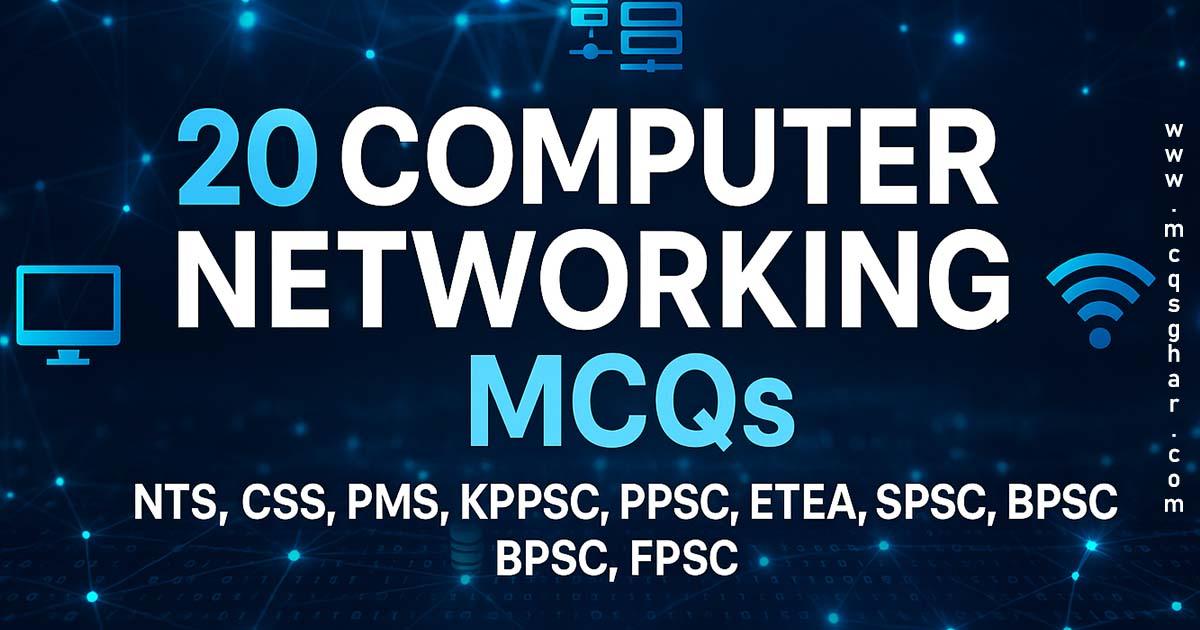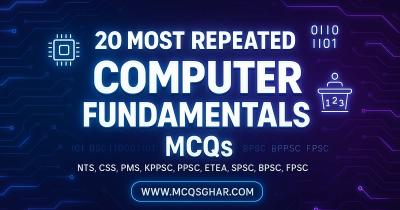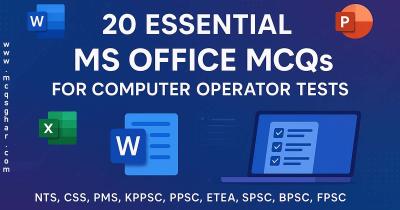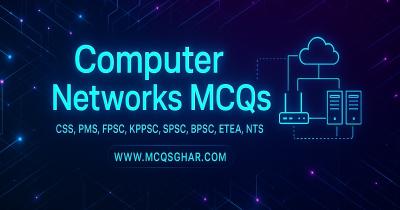بِسْمِ اللَّهِ الرَّحْمَنِ الرَّحِيم
20 Computer Networking MCQs for NTS, CSS, PMS, KPPSC, PPSC, ETEA, SPSC, BPSC, and FPSC
For aspirants of high-level competitive exams like NTS, CSS, PMS, KPPSC, PPSC, ETEA, SPSC, BPSC, FPSC, and Computer Science Lecturer positions, Computer Networking is a non-negotiable area of expertise. It is the backbone of modern information technology, and examiners frequently test candidates on its fundamental models, protocols, and hardware. Understanding how data travels from one point to another is crucial for any advanced IT role.
This collection of 20 MCQs is designed to test your knowledge on the most important networking topics, including the OSI and TCP/IP models, network devices, and common protocols. The questions are structured based on patterns observed in NTS, CSS, PMS, KPPSC, PPSC, ETEA, SPSC, BPSC, and FPSC past papers.
Essential Computer Networking MCQs
1. How many layers are there in the OSI (Open Systems Interconnection) model?
- 4
- 5
- 7
- 9
Answer: 7
Explanation: The OSI model is a conceptual framework that standardizes the functions of a telecommunication or computing system into seven distinct layers. These layers are Physical, Data Link, Network, Transport, Session, Presentation, and Application.
2. Which of the following devices operates at the Network Layer (Layer 3) of the OSI model?
- Hub
- Switch
- Router
- Bridge
Answer: Router
Explanation: A router is a Layer 3 device that is responsible for forwarding packets between different computer networks. It makes decisions based on IP addresses. Hubs operate at Layer 1, while Switches and Bridges operate at Layer 2.
3. The TCP/IP model is a condensed version of the OSI model. Which layer of the OSI model is NOT explicitly present in the TCP/IP model?
- Application Layer
- Transport Layer
- Session and Presentation Layers
- Network Layer
Answer: Session and Presentation Layers
Explanation: The TCP/IP model combines the functions of the OSI model's Application, Presentation, and Session layers into a single Application Layer. The TCP/IP model generally consists of four layers: Application, Transport, Internet (Network), and Link (Data Link/Physical).
4. Which protocol is used for sending email?
- HTTP
- FTP
- SMTP
- POP3
Answer: SMTP
Explanation: SMTP (Simple Mail Transfer Protocol) is the standard protocol for sending email messages across the Internet. POP3 (Post Office Protocol 3) and IMAP (Internet Message Access Protocol) are used for retrieving emails.
5. What does the acronym LAN stand for?
- Large Area Network
- Local Access Network
- Local Area Network
- Long Area Network
Answer: Local Area Network
Explanation: A LAN (Local Area Network) is a computer network that interconnects computers within a limited area such as a residence, school, or office building. WAN (Wide Area Network) and MAN (Metropolitan Area Network) cover larger geographical areas.
6. In which switching technique is a dedicated path established between the sender and receiver for the duration of the communication?
- Packet Switching
- Circuit Switching
- Message Switching
- Datagram Switching
Answer: Circuit Switching
Explanation: Circuit switching creates a dedicated, physical connection (a circuit) between two nodes before they can communicate. This circuit is maintained for the entire duration of the session, as seen in traditional telephone networks.
7. An IPv4 address is composed of how many bits?
- 16 bits
- 32 bits
- 64 bits
- 128 bits
Answer: 32 bits
Explanation: An IPv4 address is a 32-bit number, typically represented in dotted-decimal notation (e.g., 192.168.1.1). The newer IPv6 standard uses 128-bit addresses to accommodate the growing number of devices on the internet.
8. Which of the following is a connectionless protocol that operates at the Transport Layer?
- TCP
- UDP
- IP
- FTP
Answer: UDP
Explanation: UDP (User Datagram Protocol) is a connectionless, unreliable transport layer protocol. It does not establish a connection before sending data, making it faster than TCP but without guarantees of delivery, order, or error-checking. It is suitable for applications like video streaming or online gaming.
9. A device that connects two or more network segments and forwards packets between them based on MAC addresses is a:
- Hub
- Repeater
- Switch
- Modem
Answer: Switch
Explanation: A switch is a Layer 2 (Data Link Layer) device that is more intelligent than a huIt learns the MAC addresses of the devices connected to its ports and forwards data only to the intended recipient port, reducing network congestion.
10. What does FTP stand for?
- File Transfer Position
- File Transfer Protocol
- File Transfer Protection
- Fast Text Protocol
Answer: File Transfer Protocol
Explanation: FTP (File Transfer Protocol) is a standard network protocol used to transfer computer files between a client and a server on a computer network.
11. The arrangement of computers and devices in a network is called its:
- Architecture
- Topology
- Design
- Layout
Answer: Topology
Explanation: Network topology refers to the physical or logical arrangement of nodes and connections in a network. Common topologies include Bus, Star, Ring, and Mesh.
12. Which media access control method is used in Ethernet networks to handle collisions?
- CSMA/CA
- Token Passing
- Polling
- CSMA/CD
Answer: CSMA/CD
Explanation: CSMA/CD (Carrier Sense Multiple Access with Collision Detection) is the protocol used in Ethernet networks. A device first listens to the channel (Carrier Sense), and if it's idle, it transmits. If a collision is detected, it stops, waits a random amount of time, and tries again.
13. A network security system that monitors and controls incoming and outgoing network traffic based on predetermined security rules is a:
- Proxy Server
- Firewall
- Antivirus
- VPN
Answer: Firewall
Explanation: A firewall acts as a barrier between a trusted internal network and an untrusted external network, such as the Internet. It analyzes data packets and blocks those that do not meet the specified security criteria.
14. Which layer of the OSI model is responsible for data formatting, compression, and encryption?
- Application Layer
- Session Layer
- Transport Layer
- Presentation Layer
Answer: Presentation Layer
Explanation: The Presentation Layer (Layer 6) is responsible for translating data between the format the application uses and the format the network uses. This includes tasks like character code translation, data compression, and encryption/decryption.
15. What is the main function of a DNS (Domain Name System) server?
- To store and process websites
- To translate domain names to IP addresses
- To assign IP addresses to devices
- To secure network traffic
Answer: To translate domain names to IP addresses
Explanation: DNS (Domain Name System) acts as the phonebook of the Internet. It translates human-readable domain names (like www.google.com) into machine-readable IP addresses (like 172.217.16.196) that computers use to identify each other on the network.
16. The physical layer of the OSI model deals with:
- Error detection
- Routing
- Electrical signals, bits, and cables
- Process-to-process delivery
Answer: Electrical signals, bits, and cables
Explanation: The Physical Layer (Layer 1) is responsible for the physical connection between devices. It defines the specifications for the hardware, such as cables, connectors, and signaling methods, and is responsible for transmitting raw bits over the physical medium.
17. Which of the following is an example of a Wide Area Network (WAN)?
- A school's computer lab network
- A home Wi-Fi network
- The Internet
- A network connecting devices in a single office building
Answer: The Internet
Explanation: A Wide Area Network (WAN) is a network that covers a broad area (i.e., any network whose communications links cross metropolitan, regional, or national boundaries). The Internet is the largest and most well-known example of a WAN.
18. URL stands for:
- Universal Resource Locator
- Uniform Resource Locator
- Universal Resource Location
- Uniform Resource Location
Answer: Uniform Resource Locator
Explanation: URL (Uniform Resource Locator) is the address of a resource on the Internet. It specifies the protocol to use (e.g., HTTP), the domain name, and the specific path to the resource.
19. A Hub is a device that operates at which layer of the OSI model?
- Layer 1 (Physical)
- Layer 2 (Data Link)
- Layer 3 (Network)
- Layer 4 (Transport)
Answer: Layer 1 (Physical)
Explanation: A hub is a simple networking device that operates at the Physical Layer. It receives a signal on one port and broadcasts it to all other ports, without any filtering or intelligence. This is why it is sometimes called a "dumb" device.
20. TCP is a:
- Connection-oriented protocol
- Connectionless protocol
- Protocol for sending email
- Protocol for naming hosts
Answer: Connection-oriented protocol
Explanation: TCP (Transmission Control Protocol) is a connection-oriented protocol. It establishes a reliable connection between two devices before sending data, and it includes mechanisms for error-checking and ensuring that packets are delivered in the correct order.




